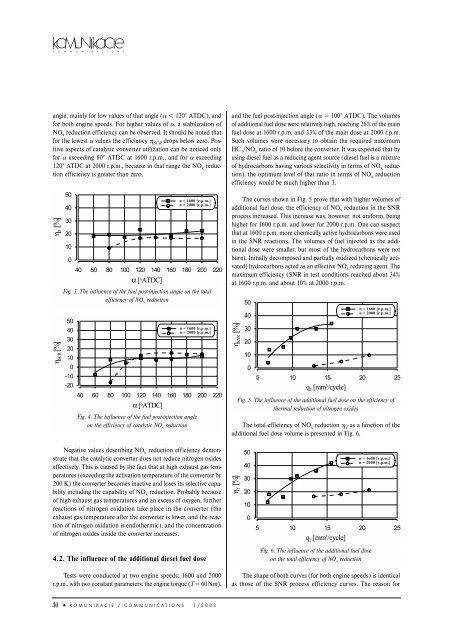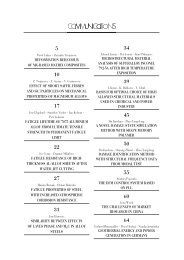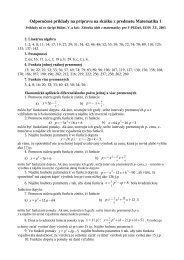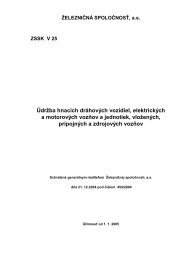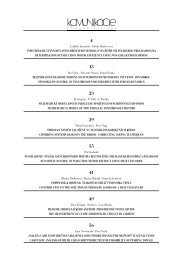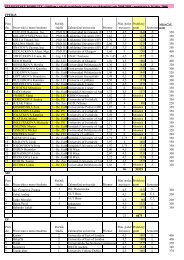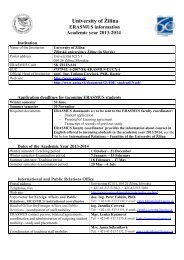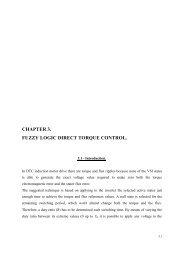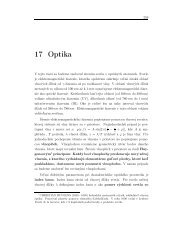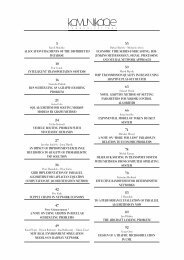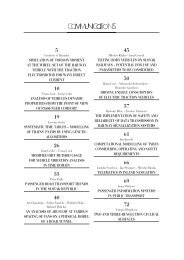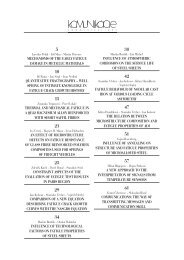posudzovanie vplyvu automobilovej dopravy na ... - Žilinská univerzita
posudzovanie vplyvu automobilovej dopravy na ... - Žilinská univerzita
posudzovanie vplyvu automobilovej dopravy na ... - Žilinská univerzita
Create successful ePaper yourself
Turn your PDF publications into a flip-book with our unique Google optimized e-Paper software.
C O M M U N I C A T I O N S<br />
I S<br />
angle, mainly for low values of that angle ( 120° ATDC), and<br />
for both engine speeds. For higher values of , a stabilization of<br />
NO x reduction efficiency can be observed. It should be noted that<br />
for the lowest values the efficiency SCR drops below zero. Positive<br />
aspects of catalytic converter utilization can be noticed only<br />
for exceeding 80° ATDC at 1600 r.p.m., and for exceeding<br />
120° ATDC at 2000 r.p.m., because in that range the NO x reduction<br />
efficiency is greater than zero.<br />
Fig. 3. The influence of the fuel post-injection angle on the total<br />
efficiency of NO x reduction<br />
and the fuel post-injection angle ( 100° ATDC). The volumes<br />
of additio<strong>na</strong>l fuel dose were relatively high, reaching 26% of the main<br />
fuel dose at 1600 r.p.m. and 33% of the main dose at 2000 r.p.m.<br />
Such volumes were necessary to obtain the required maximum<br />
HC 1 /NO x ratio of 10 before the converter. It was expected that by<br />
using diesel fuel as a reducing agent source (diesel fuel is a mixture<br />
of hydrocarbons having various selectivity in terms of NO x reduction),<br />
the optimum level of that ratio in terms of NO x reduction<br />
efficiency would be much higher than 3.<br />
The curves shown in Fig. 5 prove that with higher volumes of<br />
additio<strong>na</strong>l fuel dose, the efficiency of NO x reduction in the SNR<br />
process increased. This increase was, however, not uniform, being<br />
higher for 1600 r.p.m. and lower for 2000 r.p.m. One can suspect<br />
that at 1600 r.p.m. more chemically active hydrocarbons were used<br />
in the SNR reactions. The volumes of fuel injected as the additio<strong>na</strong>l<br />
dose were smaller, but most of the hydrocarbons were not<br />
burnt. Initially decomposed and partially oxidized (chemically activated)<br />
hydrocarbons acted as an effective NO x reducing agent. The<br />
maximum efficiency (SNR in test conditions reached about 34%<br />
at 1600 r.p.m. and about 10% at 2000 r.p.m.<br />
Fig. 4. The influence of the fuel post-injection angle<br />
on the efficiency of catalytic NO x reduction<br />
Fig. 5. The influence of the additio<strong>na</strong>l fuel dose on the efficiency of<br />
thermal reduction of nitrogen oxides<br />
The total efficiency of NO x reduction T as a function of the<br />
additio<strong>na</strong>l fuel dose volume is presented in Fig. 6.<br />
Negative values describing NO x reduction efficiency demonstrate<br />
that the catalytic converter does not reduce nitrogen oxides<br />
effectively. This is caused by the fact that at high exhaust gas temperatures<br />
(exceeding the activation temperature of the converter by<br />
200 K) the converter becomes i<strong>na</strong>ctive and loses its selective capability<br />
including the capability of NO x reduction. Probably because<br />
of high exhaust gas temperatures and an excess of oxygen, further<br />
reactions of nitrogen oxidation take place in the converter (the<br />
exhaust gas temperature after the converter is lower, and the reaction<br />
of nitrogen oxidation is endothermic), and the concentration<br />
of nitrogen oxides inside the converter increases.<br />
4.2. The influence of the additio<strong>na</strong>l diesel fuel dose<br />
Tests were conducted at two engine speeds: 1600 and 2000<br />
r.p.m., with two constant parameters: the engine torque (T 60Nm),<br />
Fig. 6. The influence of the additio<strong>na</strong>l fuel dose<br />
on the total efficiency of NO x reduction<br />
The shape of both curves (for both engine speeds) is identical<br />
as those of the SNR process efficiency curves. The reason for<br />
30 ● KOMUNIKÁCIE / COMMUNICATIONS 1/2003


